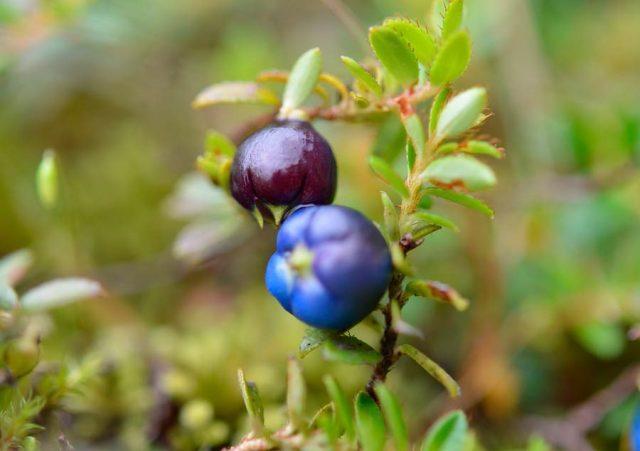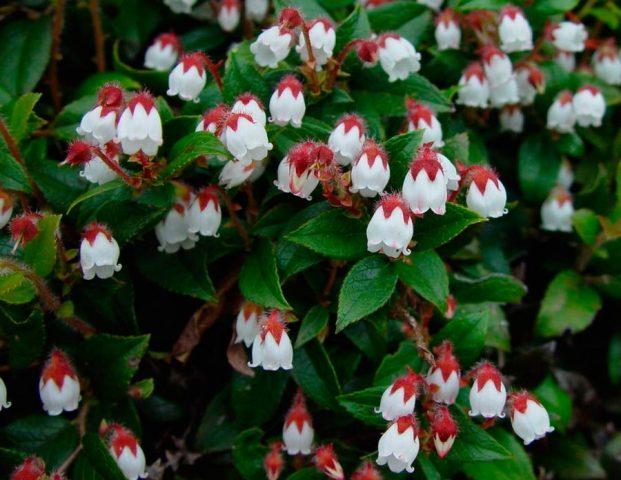Content
Wintergreen is cultivated in urban and rural areas as an ornamental plant. Another name for the evergreen shrub is “tea berry.” The natives of America once prepared drinks from its leaves that were considered medicinal. Photos and descriptions of wintergreen will help gardeners better understand the characteristics of the popular plant.

Landscape designers and amateur gardeners willingly use wintergreen to decorate their plots.
Description of wintergreen with photo
Gaultheria (wintergreen) is a representative of the Heather family, which includes 80 different species. The plant is named after the French botanist and physician Jean-François Gautier, who was engaged in the scientific study of flora. In nature, wintergreen is found in Australia, New Zealand, Asia, North and South America.
Evergreen shrubs grown in temperate climates are small in size. The dense, shiny leaves of wintergreen are single-cut. At the beginning of summer, pinkish flowers similar to lilies of the valley appear on the branches.Fragrant buds grow singly or collected in clusters. Wintergreen flowers look spectacular both in a flowerbed and in flowerpots, which is clearly visible in the photo. The fruits and berries resemble cranberries in appearance and are bright red, dark blue or white.

Wintergreen begins to bloom at the end of spring and lasts all summer.
Wintergreen belongs to the category of slow-growing plants. Under good conditions, the crop retains excellent decorative qualities for 50 years.
Is it possible to eat wintergreen berries?
Wintergreen berries look very appetizing: they are brightly colored and seem juicy. The fruits look especially impressive against the background of dark green leaves. Despite their visual appeal, the berries of the plant can hardly be called tasty: they are not juicy and hard. Wintergreen fruits are not eaten fresh, but skilled housewives use them to make jams and as a filling for pies.
Varieties and types
Of the entire variety of wintergreen plants, gardeners cultivate a small part of them. Only a few varieties are the most popular.
Pilifolia or hairy
The homeland of hairy wintergreen is southeast Asia. The plant is 10 cm tall and covered with gray-green foliage. Small flowers look like pink bells of lily of the valley. Ripe berries are bright blue in color.

Hairy wintergreen is neutral: the plant is not classified as poisonous, but also has no healing properties
Ovate-leaved
Ovate-leaved wintergreen grows naturally in North America. The bushes, growing up to 30 cm, are covered with oval leaves with pointed ends.The flowers resemble fragile lilies of the valley in shape and color.

The red perianth gives the variety a distinctly decorative appearance.
Prostrate
Native to North America, prostrate wintergreen has rounded leaves with jagged edges. Single axillary flowers do not exceed 5 mm in length. The berries of the plant are colored deep red.

The variety was named for its small size and creeping stems.
Glandular
Growing on the Japanese islands, wintergreen prefers poor soils typical of rocky mountains. The low plant has an unusual shape of leaf blades - elongated, with a jagged edge. Bell flowers are white on the outside with scarlet perianths, and pink on the inside. The bright red berries are large, with speckled spots.

Most often, wintergreen glandular can be found in coniferous forests
Wintergreen challon
The bushes of the most popular wintergreen variety, challon, are taller than other species. The height of the plant is 50 cm. The paniculate inflorescences are pink or white. Purple fruits acquire a deep black hue over time.

Shallon was introduced from North America and cultivated in Europe for almost 200 years.
Michela
Wintergreen Michela is native to eastern Asia. The shrub growing on Sakhalin and the Kuril Islands is resistant to cold and develops well even on rocks. The dark green leaves are very dense, the bell-like flowers are collected in clusters. Ripe fruits are extremely beautiful - white, glossy and shiny.

It is rare in Mikel's gardens, since the cultivation of the variety requires special conditions.
Recumbent
Small bushes creeping along the ground with large, rounded leaves are the hallmarks of wintergreen. The flowers are shaped like water lilies; ripe berries are bright red.

In recumbent wintergreen, flowers, leaves and fruits have a specific odor
Growing wintergreen in open ground
Areas located in partial shade are most suitable for growing wintergreen, since in the sun the plant can dry out, and in the shade it can die from lack of light. All varieties of shrubs grow well in loose soil with a high level of acidity. The plant is planted in a hole 30-35 cm deep, having previously created a drainage layer of pebbles and rotten needles in it. The root collar is left at ground level or deepened by 1 cm. Watering is organized rarely, but it should be plentiful. In hot weather, plantings should be sprayed every evening.
Mineral complexes (Kemira, nitroammofoska) are suitable as fertilizers for shrubs. At the beginning of summer, the plant should be fed with a composition that does not contain nitrogen.
For wintering wintergreen, as a rule, no additional shelter is required. But in the first year of life, the bushes should be insulated with a layer of peat or fallen leaves. If the snow layer in winter is scanty, then the decorative crop must be covered with spruce paws. In the spring, the protective layer must be eliminated, since harmful insects and fungal spores remain in last year’s mulch.

It is advisable to plant bushes in groups, maintaining a distance of 20-25 cm between plants
Growing wintergreen at home
When breeding wintergreen, it is necessary to strictly follow the growing rules. Agricultural technicians recommend refusing to sow seeds, since another type of shrub may grow instead of the desired variety. It is best to purchase ready-made cuttings or branches with roots.For planting you need:
- special soil with soft fertilizer;
- pot with drainage holes.
The flowerpot is not completely filled with earth. There should be about 5 cm left from the soil to the edge of the pot. A seedling is placed in the hole, covered with soil and watered abundantly.
Regular care includes:
- Place in a well-lit area (but away from direct sunlight).
- Watering at the roots in dry soil.
- Feeding with granular and liquid formulations intended for decorative foliage plants once a month.
- Pruning foliage and flowers.
It is recommended to fertilize a houseplant with a composition intended for heather and rhododendron crops. Fertilization of the land is carried out simultaneously with irrigation. Dry air and excessive heat are detrimental to the crop. Features of growing wintergreen as a houseplant.
Reproduction methods
The seed method for propagating ornamental shrubs is not used, since the characteristics of the species may not appear in a young plant. It is preferable to use a vegetative method to spread wintergreen, in which:
- One or more shoots are bent to the ground and covered with soil.
- Plantings are watered abundantly.
- In the fall, after the roots appear, the shoots are replanted.
Another way to propagate a plant is by cuttings. To do this, lignified shoots are cut off and divided into several parts. The cuttings are planted in containers with sand, watered and exposed to the sun. When the sprouts take root, they are moved to open ground.
Diseases and pests
If the bushes grow on soil with a pH level shifted towards acidity, then diseases do not threaten the plant. Alkaline soil and excessive moisture cause poor growth and infection by pathogenic fungi. With insufficient soil looseness and frequent watering, ornamental crops suffer from powdery mildew and black mold. Shrubs can also be damaged by mites. Leaves affected by the disease must be torn off and burned to prevent further spread of the infection.
Conclusion
Photos and descriptions of wintergreen will be a good help to amateur gardeners who decide to cultivate the plant on their own plot. Each decorative variety, with good care, looks very attractive and can become a decoration of a garden or park.








